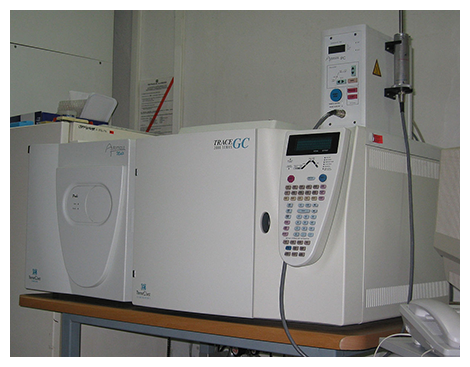Gas chromatography is the primary method for blood testing for DWI cases in Texas—those that involve alcohol, and those that do that. When someone gets arrested for DWI, chances are there is blood test. Breath tests, formerly the norm, have taken a backseat to blood tests and gas chromatography. Blood tests are preferred by police and prosecutors as an enforcement tool. It is seen as more reliable evidence. So, what is gas chromatography and how does it work? It is an analytical technique designed to separate and analyze the molecules in a sample. The process identifies and distinguishes alcohol (ethanol) concentrations in blood samples. Gas chromatography can take a complex mixture like human blood and separate the ethanol from all the other stuff in the blood, identify ethanol, and measure the quantity of ethanol.

Is Gas Chromatography Reliable?
Gas chromatography is a valid and reliable scientific method, if it’s done properly. If it’s not done properly, it is unreliable and invalid. However, the jury will not know that it is—unless a defense attorney points it out. This technique is employed in analytical chemistry and has many different and diverse uses. Obviously, this article is only concerned with the detection of ethanol in criminal DWI cases.
How does it work? What are the pitfalls? How can it go wrong? And how can gas chromatography be undermined to raise enough doubt to help you in your criminal case?
Gas Chromatography is a Separation Technique
As discussed above, headspace chromatography is used for identifying and measuring alcohol (ethanol) levels in a person’s blood. How a person’s blood is prepared to go into the chromatograph and what other compounds are added to it is an involved process. See DWI Blood Draws. Ethanol is measured in blood in terms of grams per 100 milliliters (or per deciliter.) The legal limit in Texas is .08 grams per deciliter. If utilized properly, gas chromatography can accurately measure these levels. However, it is not enough just to measure ethanol. The gas chromatograph must be taught what alcohol is. Calibration is teaching the gas chromatograph what ethanol is with measured standards, so that it can be recognized in unknown samples. More on how the machine does this below. To work properly, it must be set up properly, operated properly, and interpreted properly.
How Does the Sample Move Through the Machine?
Gas chromatography takes a very small sample from the headspace of a blood vial and this gas gets injected into the injection port (inlet) of the gas chromatograph. At this point, a gas pushes the sample through a column. The gas that moves the sample through the column is helium. The column is very thin and long, and it is wound up like a garden hose inside of the oven. The inside of the column is coated with a silica gel. The chemicals in the silica are designed to react with the different molecules of the sample in different ways. Molecules have different reactions with the chemicals in the column, and travel through the column at different rates. This is how separation occurs. When a molecule leaves the column, the flame ionization detector measures the quantity. Leaving the column is called elution. When a molecule elutes the column, the flame ionization detector measures the current of the effluent in terms of pico-amps. This is how ethanol is eventually quantified into a grams-per-deciliter measurement.
What is a Chromatogram?
After the sample separates inside the column and the flame ionization measures the sample, the data shows the individual peaks, or measurements, of the separated molecules and the time that they come out of the column. The time that it takes a molecule to elute from the column is called retention time. The data printout is called a chromatogram. The analyst looks at the data to identify and quantify ethanol from the sample. The machine has already been taught what ethanol is from certified ethanol standards. The sample also has an internal standard that is added to the blood. The internal standard is called n-propanol. Ethanol and n-propanol will elute at different times. N-propanol is also an alcohol, but will never be found in the human body. N-propanol is added to the blood sample. Ethanol is measured indirectly. The unknown amount of ethanol is measured against a known amount of n-propanol.
What Could Possibly Go Wrong?
Garbage In Means Garbage Out
As noted above, gas chromatography is a valid and reliable scientific method of analysis if care and diligence and precaution are taken. If not—any honest scientist will tell you—gas chromatography is unreliable. User error, maintenance issues, calibration issues, are all problems that can compromise the result. If the result is compromised, it is not valid. This is what garbage in, garbage out means. From the time the blood is taken from a person’s arms, human error can come into play. For the problems preparing the blood sample, look at my page on DWI blood draws. After the blood gets prepared and loaded into the autosampler, there are a host of problems. The injection port is where the sample enters the machine before getting pushed into the column. Here are several things that can go wrong just with the inlet (where the sample is injected) on the gas chromatograph.
- Leaky septum
- Split flow problems
- Helium line pressure issues
- Plugged syringe
- Liner overload
- Plugged split vent
- Temperature problems
- Dirty inlet
- Column overload
- Column flow problems
- Loose column nut
What are Some Problems with Separating Ethanol?
As noted above, the gas chromatograph is designed to separate complex mixtures. It is designed to separate ethanol in blood. This is the entire point of gas chromatography. But what if there are problems separating ethanol molecules from everything else? If gas chromatography cannot separate, it is a useless and expensive hunk of scrap metal. On the gas chromatogram, there should be tall and skinny individual peaks that are completely isolated from one another. If these peaks are overlapping, substances can be leaving the column at the same time. This is called co-elution. This is a bad, bad thing to see on a chromatogram, because it tells us that the machine cannot do what it is designed to do. If ethanol is co-eluting with another substance, the detector could be over-measuring ethanol content in the sample. This invalidates the entire process. Separation can be a function of temperature, column diameter and length.
What are Some Problems with Reporting a Blood Alcohol Score?
When a person gets a DWI, and gets their blood score back, sometimes they are very surprised. When all you see is the one-page printout with an ethanol result on it, this piece of paper has an authoritative and dooming bearing. However, this piece of paper means nothing. There is a lot of work behind this piece of paper that went into coming up with that score. Was it good work or was it sloppy work? More information is needed to know. However, there are two serious problems with a gas chromatogram will falsify the result.
Reporting the Wrong Peak as Ethanol
On a chromatogram there will be at least two peaks—one for ethanol and one for the internal standard, n-propanol—and possibly there could be other substances in the blood as well. Which peak the machine determines is ethanol is a factor of retention time—i.e., how long it takes ethanol to elute from the column. If the machine identifies the wrong peak as ethanol, this is obviously a major problem. The misidentified peak could be higher or lower than the ethanol peak. Regardless, the resulting number will be completely wrong and invalid. Retention times for ethanol in unknown samples should closely match the retention times for ethanol standards. If they do not, this can signal that the machine is misidentifying peaks. Laboratories can avoid this issue, and safeguards can be implemented to prevent this. The lab should use two columns for confirmation. Using two columns is called dual-column analysis, and showing that ethanol can be identified twice on two different columns can help resolve any doubt that the machine is misidentifying peaks. Furthermore, the lab could also use a mass spectrometer to confirm that the peak is alcohol. This is the most reliable method because the mass spectrometer substances on a molecular level.
Reporting the Wrong Concentration of Ethanol
The gas chromatograph can also report the wrong quantity of ethanol. This is perhaps a more common problem than falsely identifying a peak. Reporting the wrong amount of ethanol is harder to prevent and harder to trace than reporting a wrong peak as ethanol. There can be many reasons that a gas chromatograph can report a wrong concentration of ethanol. Maybe the calibration was not done properly. There could be carryover ethanol from the previous sample. If the sample preparation was done incorrectly, this could certainly cause the machine to report the wrong amount of ethanol. The machine has no idea that the preparation was done incorrectly, so it will measure and report whatever is in the vial.
What are Calibration Problems that Can Affect the Results?
Calibration is a very crucial part of gas chromatography. The machine must be taught what ethanol is, and what standard different quantities of ethanol is. The machine must be taught every time what .08 is, and what other quantities of ethanol for the calibration curve are. If something goes wrong with the calibration, the resulting report will be non-validated. Here is a list of issues that can arise regarding calibration:
- Internal standard preparation errors
- Internal standard too low or too high
- Analytes too low or too high
- Balance problems (calibration, temperature)
- Pipette problems
- Glassware problems
- Evaporation
- Sample vial not sealed
- Contamination
- Degradation of standards
- Quality of reference material
What Are Some Problems with Headspace Analysis?
In DWI testing, gas chromatography does not actually measure the blood, but the air above the blood in the blood tube. This is called headspace analysis. If the tube is subject to constant pressure and temperature, ethanol will exist in the air in the blood tube above the actual blood in a measurable ratio. This process is called headspace chromatography, and is a great and precise tool for analysis if the parameters are correct, and if operated properly. Most people are surprised to learn the that gas chromatograph does not actually test the blood, but the gas vapors above the blood in the vial. The reason why blood is not injected directly into the injection port of the gas chromatograph is that there are proteins and other biological material in blood that would gunk up the inlet. This would require cleaning after every sample to prevent the contamination of future tests. This would be very inefficient. Theses gas samples is injected into the inlet and this is tested. This allows for the machine to run many tests efficiently. As with all other aspects of gas chromatography, there is potential for error. Here are some problems that can come up with headspace analysis:
- Leaky vial cap or valve
- Ethanol carryover from prior samples
- Cold spot in transfer line
- Differences in salt concentrations in sample and standard
- Wrong sample amounts added to vial
- Problems with internal standard addition
If you have any more questions about gas chromatography, call me or email me. I am very passionate about forensic science and defending people. I would love to talk to you and answer all of your questions, if I can.









